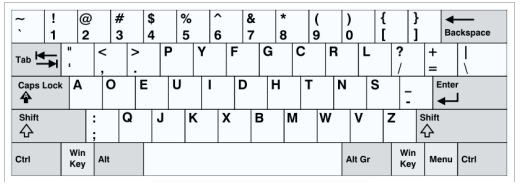Advantages of the Dvorak Keyboard vs the QWERTY Keyboard
It should come as no surprise that the modern computer keyboard layout known as QWERTY owes its existence to an anachronism in today’s high-tech world. The QWERTY keyboard, so named for the first six letters across the top row of keys, was developed for the typewriter invented in the late nineteenth century. However, the QWERTY layout is but one of several competing standards that have appeared over the years as the main input peripheral of both typewriters and computers. The Dvorak keyboard layout attempts to provide a more efficient typing experience for the typist but falls short on widespread adoption because of a standard laid down long before computers were conceived.
A Brief History of the QWERTY Keyboard Layout
The first typewriters had simple keyboard layouts in which the letters of the English alphabet were arranged from A to Z on two or three rows. The problem with this layout was that the keys would often get stuck and jam. When two letters that were often typed in succession were near one another, the arms that swung up to stamp the page would jam because they were trying to occupy nearly the same space at the same time. The invention of the QWERTY keyboard placed letters likely to be used in succession far from one another, hence the seemingly random placement of the letters on the keyboard. Essentially, the QWERTY keyboard was invented to make typing less efficient to avoid the jamming of typewriter arms rising up to stamp the page.
The Dvorak Keyboard Layout
To combat the inefficiency of the QWERTY keyboard and to take advantage of the better-made, modern typewriter, August Dvorak (1894-1975) patented the Dvorak keyboard in the mid-1930s. Of particular note, Dvorak keyboards place the vowels (the letters most used in the English language) in the center of the left side of the keyboard. The least-used letters occupy the bottom row with the seldom used of these to the far right and far left. The most often used consonants are controlled by the strongest fingers of both hands and placed near the center of the top row. The purpose of this layout is to allow the most dexterous fingers, the pointer and middle fingers, to control the majority of the typing while relegating the least used letters to the least-dexterous fingers, the pinky and ring fingers.
Advantages and Disadvantages of the Dvorak Keyboard Layout
The main advantage of the Dvorak layout is more intuitive positioning of the most frequently used keys while at the same time reducing the inefficiencies associated with placing seldom-used keys in control of the most dexterous fingers. The typists can control the vowels with just the left hand leaving the right hand free to manipulate the most important consonants. Although somewhat out of date today, the belief that most people are right handed led to the manipulation of the most keys (the consonants) by the right hand. However, even left-handed typists find that control of the vowels by just one hand results in more efficient (faster and accurate) typing.
It has been posited that learning to type on a Dvorak keyboard by the uninitiated proceeds faster than with the QWERTY layout. This seems incomprehensible for a typist attempting to switch from QWERTY to Dvorak but the novice typist finds the layout intuitive rather than that of the seemingly random placement of keys on the QWERTY keyboard. However, teaching the Dvorak layout to novice typists serves as an injustice to the student as he/she is soon released into a QWERTY-dominant world where a relearning must take place to conform to the current standard. The most important disadvantage of the Dvorak layout is steeped more in learning than in manipulation of keys on a keyboard. The QWERTY layout has stood the test of time as the standard layout since its inception on the earliest typewriters. For over a century, the QWERTY standard continues to be the layout taught in schools and found on most computer keyboards. Any campaign to switch the layout from one to the other would face opposition of the familiar and ingrained layout currently reigning. Even individuals using the Dvorak layout have trouble switching to another keyboard using the QWERTY layout. Since the majority of individuals use the standard keyboard, switching to another is an annoyance.
Another disadvantage of using the Dvorak layout is the multiple layouts that purport to derive from the original Dvorak design. In the 1930s, computers did not exist. The keyboard of the time had no use for many of the functions found on the modern computer keyboard. Consequently, the Dvorak design had to be reinvented as the capability of the computer keyboard changed. For example, the original Dvorak layout did not have “ctrl” and “alt” keys and certainly there was no Windows key. Over time as these functions were added, the Dvorak layout changed to accommodate the additions. Also, several offspring of the Dvorak layout such as one-handed versions complicate its adoption.
Conclusion
In the pre-computer era of the mid-twentieth century, a new standard of keyboard layout devised by August Dvorak attempted to take advantage of the changing technology of typewriters. Gone were the days of jamming typewriter arms as the electric typewriter took hold over the older mechanical design. Dvorak took advantage of this increased reliability by proposing a keyboard that was more intuitive, more efficient, and easier to learn. However, the standard QWERTY layout had already positioned itself as a standard with attempts to suppress it unsuccessful. The result was the natural adoption of the QWERTY standard by the computer age. It is interesting to note that a design originally used to decrease jamming of a mechanical device should survive into the information age.
